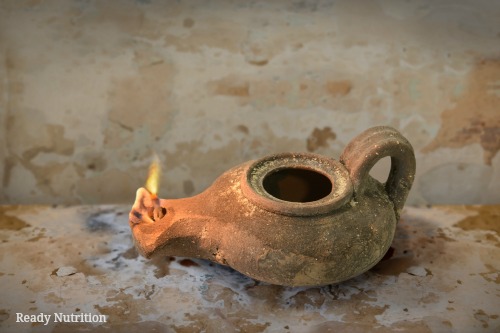
In an emergency, adapting is the key to survival. We all fear that there may come a time when our back ups have run out. In terms of the lights going out, we will need to find alternative light sources or learn to live in the dark.
When it comes to long-term preparedness, we need only look back on our ancestor’s knowledge to affirm that their methods for surviving, often considered primitive by modern standards, are effective in their own right and are applicable in the event that our modern day conveniences are disrupted. With respect to alternative light sources, sometimes the earlier ways are more efficient than the modern ones. The most simplistic and archaic type of lamp is the Canaanite lamp and dates back to 1500 BC-600 BC. This type of lamp is made of terra cotta; and although it isn’t the safest type of lamp to walk around with, it would definitely be a good source of light for stationary use. This type of light source demonstrates the simplistic nature of creating a lamp. All that is needed is a vessel, oil or fuel, and a wick. When you do not have the normal items on hand to create a lamp, there are many items that can be substituted to make an alternative source of light.
Similar in simplistic nature, you can make a candle from a container of Crisco. All you need is a wick that is attached to a metal base and a wooden skewer. Simply take the wick and push it into the Crisco with the skewer until it is pushed to the bottom of the can. Ensure that at least 1 inch of the wick is sitting out of the Crisco. Voila!
Alternative Vessels – An expensive lantern is not needed to create an emergency lamp. All you really need is a container that can hold oil and will not catch fire. Some items to consider are:
- Glass bottles
- Glass or porcelin bowls
- Used tuna cans or pet food cans
- Fruit peels with the pulp removed and cut in half (citrus fruits work very well).
- Hollowed out potatoes
- Wide-mouth glass jar or recycled glass jars
- Terra cotta containers
If you find yourself in a bind and happen to have citrus fruits laying around, a makeshift lamp can be made from citrus halves in two easy steps:
Step 1: Cut an orange in half and scoop out the flesh, leaving the long piece of white pith in the middle.
Step 2: Fill with olive oil and light the piece of pith.
Another alternative for a makeshift vessel if using empty canning jars or used food jars. To see how easy this is, click on the instructional video below.
Alternative Fuel – Although having kerosene fuel on hand is a great preparedness item to have to fuel lamps, in a long-term emergency, it is a precious item to that many would want to conserve. Olive oil or other types of cooking oil are great options to use in lieu of fuel to create illumination. A few ounces of oil can burn for several hours, so it is also cost effective. Olive oil is 99% pure renewable fuel and does not produce smoke or odor. However, other cooking oils such as canola or corn oil may have the potential to produce smoke and odor, so use caution. According to Mother Earth News, olive oil is much safer to use compared to using candles or kerosene. Because of the high flash point olive oil has, it is not a very flammable material and will stop burning if spilled or knocked over.
Recycling food oils would be a great way to make use of what you have on hand. Used cooking oils and even oil packed canned goods can be used to create lighting. See the video below.
Alternative Wicks
In a long-term emergency, you will never have enough wicks. Therefore, stock up on this low cost, essential prep items while you still can. Candle making supply stores will have a large assortment of wicks to choose from. Further, some self-sufficient stores such as Lehman’s can also help.
A few tricks that Mother Earth News shared to make your wicks burn longer is to salt it. To salt your wick, take your cotton twine, put it in a bowl with a little water and then cover with table salt. Squeeze it dry and let it dry overnight, or until it is no longer damp.
If you need or want your lamp to emit more light, try using a braided, flat wick (a half inch or narrower), adjusting the way the wire supports this kind of wick by crimping it to accommodate the extra girth. You can make your own wicks out of cotton materials like old towels or even socks. Keep in mind to find alternative wick materials that do not produce any harmful fumes that could cause any health problems. I like to stick with cotton materials when making wicks.
Some alternatives to candle wicks can be:
- Cotton string or twine
- Paper towel
- Torn pieces of cloth
- Shoe lace (with the plastic coating cut off)
- Old cotton sock (that is clean) torn into strips
- Cotton towel torn into strips
Having a means of light during an emergency situation, (especially a longer-term emergency) can be a great asset to have on hand. By using the basic foundation that our ancestors laid out for us, our homes can still emit light in a non-technological world; we just have to know which tools to use and how to use them.
For more information, turn to these instructional pages:

Excellent article, it is actually very cheap and easy to make candle wicks, and like you say – you can never have enough of them in emergencies!, so well worth stocking up on in advance!